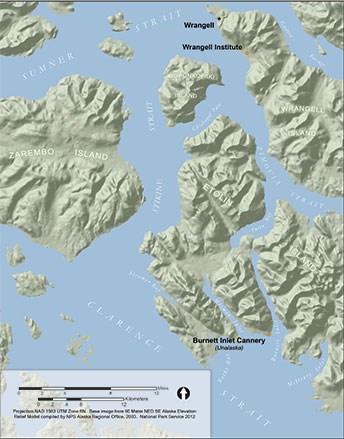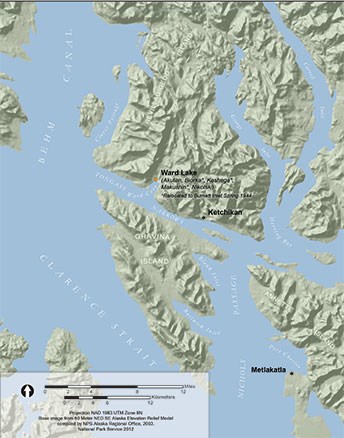|
For most people, the Aleutians are a far-away place. Maps help you visualize the places and distances involved in far-away stories. ImprisonmentAfter invading Attu, Japanese forces took the islanders to Japan as prisoners. Their ordeal lasted several years as they traveled the entire width of the Pacific Ocean. 
NPS with projection WGS 1984 Web Mercator Auxiliary Sphere. Base image from World Shaded Relief Map compiled by ESRI ArcGIS Online and Data Partners. Evacuation and InternmentWith the supposed goal of protecting the Unangax̂ (Aleut) people, the American military forced nearly 900 villagers to move from their homes in the Aleutian Islands to Southeast Alaska, a journey of a thousand miles. The military burned their villages, to prevent the Japanese from finding any resources that might aid their war effort. The Unangax̂ spent years in living in makeshift, poor-quality camps in Southeast Alaska before being returned to the Aleutians; and even then, some were not permitted to return to their former villages. 
SS Delarof 6-17 to 24-42). Blue arrow from DH (160 ppl on SS Columbia 7-6 to 13-42) to Wrangell Institute (WI). Brown arrow from DH (111 ppl to WI on SS Alaska 7-26-42). Blue & purple return arrows of 350 ppl on USAT David W. Branch Apr and Dec 1945. 
NPS 
Burnett InletA disused cannery became home in Burnett Inlet. Food shortages and dreadful conditions awaited the unlucky internees. 
KillisnooAccustomed to living in a world without trees, one open to the expansive sky, the Unangax̂ suddenly found themselves crowded under the dense, shadowed canopy of the Southeast rainforest. For two years they would remain in these dark places, struggling to survive. 
Funter BayLike in Burnett Inlet, evacuees taken to Funter Bay lived in poor conditions. A disused cannery and old mine became home for them, and buildings often lacked heat, water, electricity - even doors. 
Ward LakeThough taken so far from their homes, and kept in poor quality "duration villages" during the war, the Unangax̂ remained patriotic and loyal to the United States of America. By 1945, as hostilities came to an end, the Unangax̂ resettled many of their former villages. Some of those villages remain empty, however, no longer a home after the forced removal of villagers. |
Last updated: August 7, 2024
